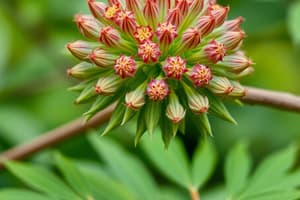Podcast
Questions and Answers
Angiosperms make up approximately 70% of all green plants worldwide.
Angiosperms make up approximately 70% of all green plants worldwide.
False (B)
The origin of angiosperms can be traced back to the early Cretaceous period.
The origin of angiosperms can be traced back to the early Cretaceous period.
False (B)
Flowers in angiosperms are developed from modified stems.
Flowers in angiosperms are developed from modified stems.
False (B)
Fruits in angiosperms primarily serve as protective structures for the reproductive organs.
Fruits in angiosperms primarily serve as protective structures for the reproductive organs.
Angiosperms are classified under the division Anthophyta in the APG III botanical classification system.
Angiosperms are classified under the division Anthophyta in the APG III botanical classification system.
The diverse life forms of angiosperms arise from their unique reproductive structures: leaves and roots.
The diverse life forms of angiosperms arise from their unique reproductive structures: leaves and roots.
Angiosperms rely solely on the participation of all cells in the plant body for basic functions like nutrition, photosynthesis, and cell division.
Angiosperms rely solely on the participation of all cells in the plant body for basic functions like nutrition, photosynthesis, and cell division.
Non-vascular plants have vascular tissue like xylem and phloem for translocation of water and nutrients throughout the plant.
Non-vascular plants have vascular tissue like xylem and phloem for translocation of water and nutrients throughout the plant.
Meristems and cambia are specialized regions in angiosperms that regulate the extension of the plant's length and width.
Meristems and cambia are specialized regions in angiosperms that regulate the extension of the plant's length and width.
Angiosperms are less dominant in terrestrial ecosystems compared to non-vascular plants.
Angiosperms are less dominant in terrestrial ecosystems compared to non-vascular plants.
Angiosperms do not contribute significantly to human society as sources of pharmaceuticals, fiber products, and other commercial products.
Angiosperms do not contribute significantly to human society as sources of pharmaceuticals, fiber products, and other commercial products.
The adaptability of angiosperms allows them to thrive only in specific habitats.
The adaptability of angiosperms allows them to thrive only in specific habitats.
Flashcards are hidden until you start studying
Study Notes
Overview of Angiosperms
Angiosperms, commonly known as flowering plants, represent the largest and most diverse group within the kingdom Plantae. Comprising approximately 80% of all green plants currently alive, there are estimated to be about 300,000 species of angiosperms worldwide. This vast diversity of life forms arises from their unique reproductive structures: flowers and fruits, which enable cross-pollination and effective seed dispersal across various environments.
Evolution and Classification
The origin of angiosperms dates back to the early Jurassic period, around 180 million years ago. During this time, they emerged as a distinct group of plants with specialized features such as vascular tissue and enclosed seeds within an ovary. Angiosperms are classified under the division Anthophyta in the APG IV botanical classification system, which identifies them as vascular seed plants with enclosed ovules that develop into seeds.
Key Features and Adaptations
One of the primary distinguishing features of angiosperms is the presence of flowers and fruits, which serve essential roles in their reproduction. Flowers, developed from modified leaves, act as protective structures for the reproductive organs: stamens (which produce male gametes) and carpels (which contain female gametes). Fruits, derived from mature floral organs, facilitate seed dispersal through various mechanisms such as wind, water, or animal interactions.
In contrast to non-vascular plants, which rely solely on the participation of all cells in the plant body for basic functions like nutrition, photosynthesis, and cell division, angiosperms have evolved specialized tissues and cells that perform these tasks efficiently. These adaptations include vascular tissue (xylem and phloem) for translocation of water and nutrients throughout the plant, as well as specialized regions for plant growth called meristems and cambia that regulate the extension of the plant's length and width.
Ecological Importance and Economic Value
Angiosperms play a crucial role in supporting global ecological balance and human needs. They dominate terrestrial ecosystems, representing nearly 90% of all plant species, and provide valuable resources for wildlife as a primary source of food for many birds and mammals, including humans. In addition to their importance in natural ecosystems, angiosperms contribute significantly to human society as sources of pharmaceuticals, fiber products, timber, ornamentals, and other commercial products.
Indeed, the sheer variety and versatility of angiosperms have allowed them to adapt and thrive in diverse habitats around the world, leading to their ubiquity and dominance among plant life.
Studying That Suits You
Use AI to generate personalized quizzes and flashcards to suit your learning preferences.




